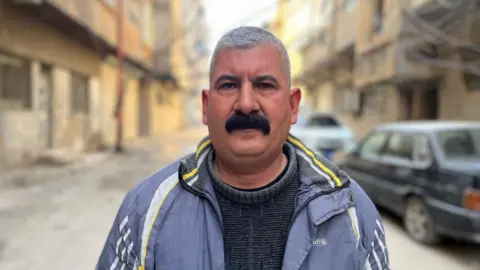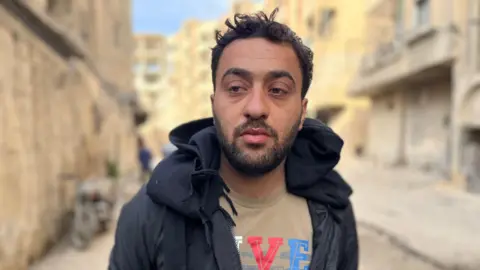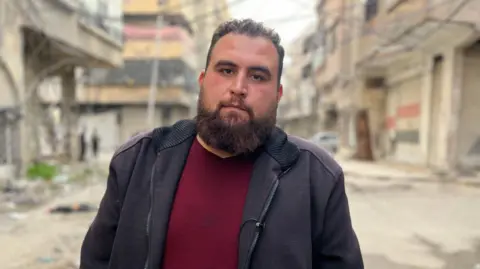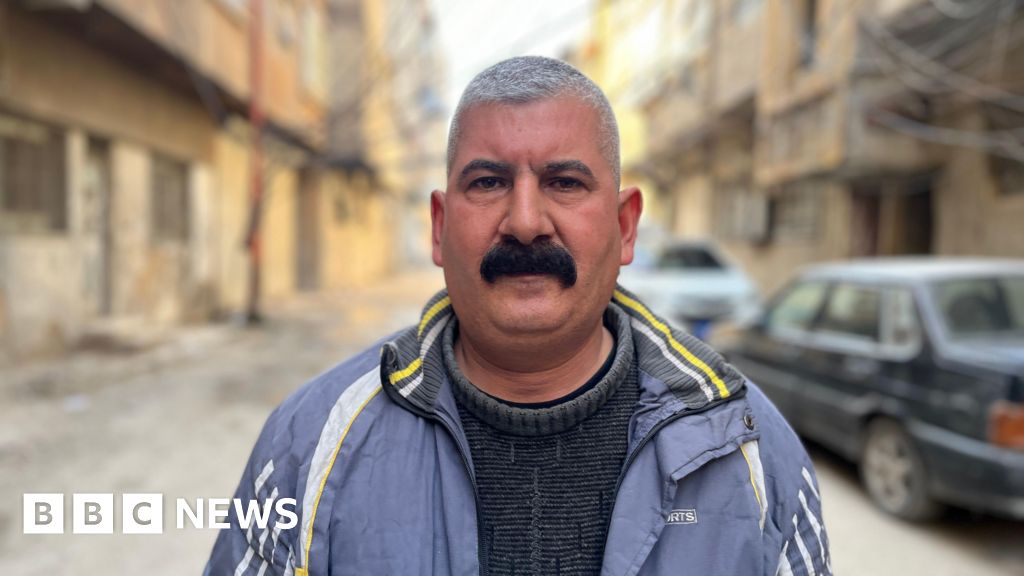 Aamir Peerzada/BBC
Aamir Peerzada/BBCTawfiq Diam is emotional because it’s the first time he’s been able to speak freely about what happened to his family back in 2018, in Douma in the Eastern Ghouta suburb of Damascus.
“If I’d spoken out before, Bashar al-Assad’s forces would have cut off my tongue. They would have slit my throat. We were not allowed to talk about it,” he says.
Tawfiq’s wife and his four children aged between eight and 12 – Joudy, Mohammed, Ali and Qamar – were killed in a chemical attack on 7 April 2018.
The Organisation for the Prohibition of Chemical Weapons (OPCW), a global watchdog, said in a report last year that it believed a Syrian air force helicopter departed from the nearby Dumayr air base shortly after 19:00 that day and dropped two yellow cylinders which hit two apartment buildings, releasing highly concentrated chlorine gas.
Tawfiq said his family was just outside his ground floor home when the bombs hit.
“I heard an explosion and people shouted on the streets ‘chemicals, chemicals’. I came running out. There was a foul smell. I saw yellow foam coming out of people’s mouths. My children were not able to breathe, they were choking. I saw people lying in the street,” he says.
The OPCW says at least 43 people were killed. Tawfiq says there were more than 100 dead.
“Even I almost died. I was in hospital for 10 days. Just five or six men in this compound survived,” he says.
Assad’s government denied ever using chemical weapons. And its ally Russia said the Douma attack was “staged”.
Eastern Ghouta was one of the most fiercely contested areas for five long years during Syria’s civil war.
The regime eventually laid siege to it and, along with its ally Russia, indiscriminately bombed the area as it sought to gain control of it from rebel fighters led by the group Jaish al-Islam.
Driving through it now, the destruction wrought upon it is all around us. It’s hard to find a single building that doesn’t bear the scars of war, many so badly bombed out, they’re just shells of structures.
On more than one occasion in Eastern Ghouta, chemical weapons – banned by the Geneva protocol and the Chemical Weapons Convention – were used to attack Douma.
Bashar al-Assad’s forces captured Douma shortly after the chlorine attack, and the stories of the victims were never fully heard.
“Not a day goes by when I don’t think of my children,” Tawfiq says pulling out the only photo he has of them, his eyes welling up with tears.
 Aamir Peerzada/BBC
Aamir Peerzada/BBCAs we talk to Tawfiq, more people come up to us to tell us their stories.
Khalid Naseer says his baby daughter Nour, his two-year-old son Omar, and his pregnant wife Fatima were also killed in the 2018 chlorine attack.
“Those who were killed were mostly children and women.”
The anger he’s had to suppress for six years comes out.
“The whole world knows Bashar al-Assad is an oppressor and a liar, and that he killed his own people. My wife was killed two days before she was due to deliver our baby,” he shouts, emotions running high.
The chlorine gas attack was not the only time chemical weapons were used in the area.
In 2013, rockets containing the nerve agent sarin were fired at several rebel-held suburbs in Eastern and Western Ghouta, killing hundreds of people. UN experts confirmed the use of sarin but they were not asked to ascribe any blame.
Assad denied his forces fired the rockets, but he did agree to sign the Chemical Weapons Convention and destroy Syria’s declared chemical arsenal.
Between 2013 to 2018, Human Rights Watch documented at least 85 chemical weapons attacks in Syria, accusing the Syrian government of being responsible for a majority of them.
In addition to Douma in 2018, the OPCW’s Investigation and Identification Team has identified the Syrian military as the perpetrator of four other cases of chemical weapons use in 2017 and 2018. An earlier fact-finding mission, which was not mandated to identify perpetrators, found chemical weapons were used in 20 instances.
Khalid and Tawfiq took us to a mound by the side of a road, a short drive away. They believe this is where the regime took their family’s bodies and buried them in a mass grave.
Looking down on the ground, amid gravel, mud and stones, pieces of bones are visible, although it’s not possible to tell if they are human remains.
“This is the first time I have set foot here, I swear to God. If I had tried to come here earlier, they (the regime) would have executed me”, says Tawfiq.
“On Eid, when I used to miss my family, I would ride by the side of this road and quickly glance towards this (the mound). It made me cry.”
Tawfiq wants the graves to be dug up, so he can give his family a dignified funeral.
 Aamir Peerzada/BBC
Aamir Peerzada/BBC“We want fresh investigations into the attack,” says Khalid. He says the testimony given by many to the OPCW fact-finding mission in 2019 was not reliable.
It’s a claim corroborated by Abdul Rahman Hijazi, one of the eyewitnesses who testified before the mission, who says he was forced to give the regime’s version of events.
“Intelligence officers detained me and told me to lie. They told me to say that people were killed because of dust inhalation not chemicals. They threatened me, that if I didn’t agree, my family will not be safe. They told me my house was surrounded by the regime’s men,” he said.
One of the findings in the 2019 OPCW report on Douma states: “Some witnesses stated that many people died in the hospital on 7 April as result of the heavy shelling and/or suffocation due to inhalation of smoke and dust.”
Abdul Rahman says he and his family were shunned by the community for years after he gave the testimony. He found it tough to get a job.
Now he also wants a fresh investigation.
“I want the truth to come out. I’m unable to sleep. I want justice for every parent.”
Additional reporting by Aamir Peerzada, Sanjay Ganguly and Leen Al Saadi


Leave a Reply